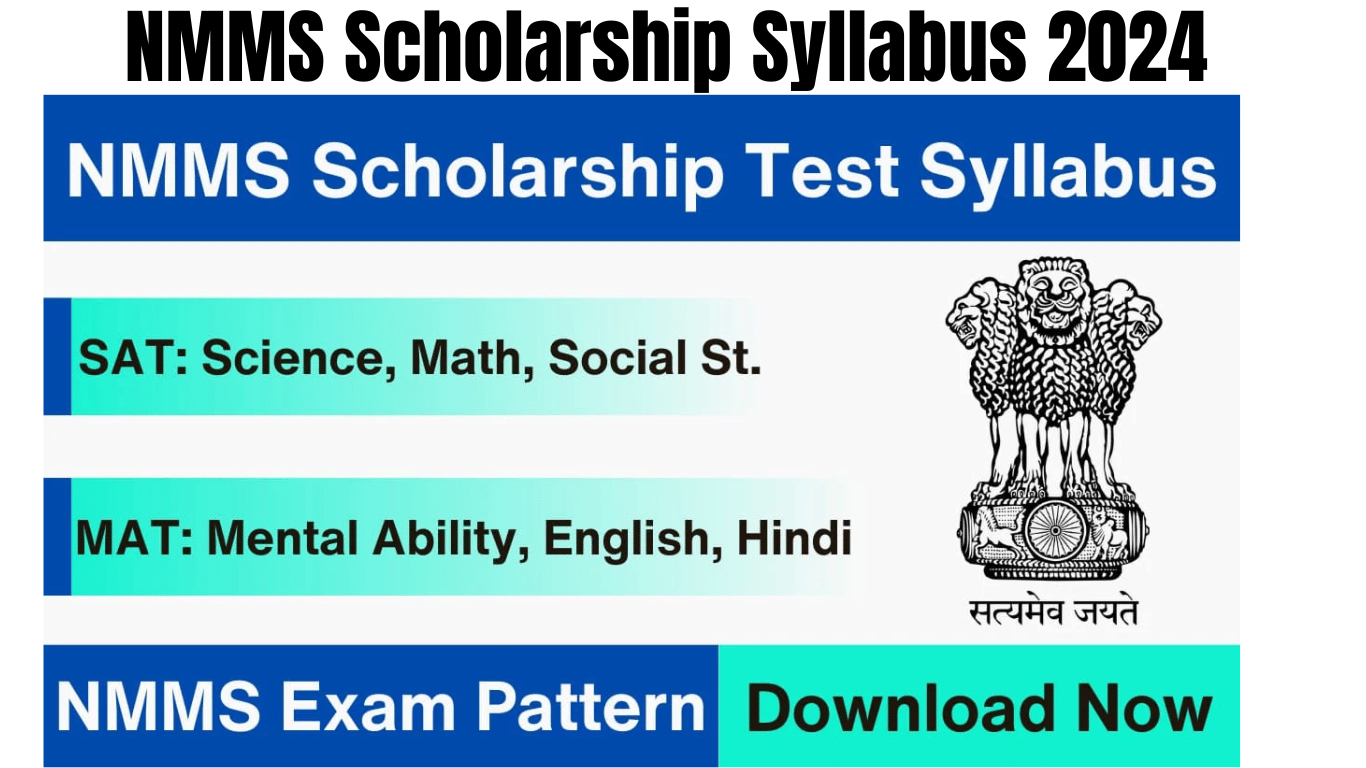NMMS Scholarship Syllabus 2024 The State Council for Education Research and Training (SCERT) has released the Exam Pattern for the NMMS and marking system. It is essential for those who are studying to take exam National Means-cum-Merit Scholarship entrance test for the session 2024-25 to become familiar with the exam’s format. Knowing the format will greatly increase their efficiency in studying for the test.
Candidates who are preparing for the test should align their learning strategy to the Syllabus of the NMMS and the exam structure. The NMMS examination format is composed of two parts: the test called MAT (Mental Ability Test) and the SAT (Scholastic Aptitude Test). Each section contains 90 multiple-choice test questions that test takers must finish in a time of 90 minutes per section. The NMMS exam evaluates students through testing their abilities in both the mental and academic aptitude tests. Keep reading for more details regarding the NMMS exam outline, the structure of the exam, and more details.\
NMMS Entrance Exam Scheme Overview
| Name of Dept | Department of School Education & Literacy, MHRD, Govt of India |
| Scheme Name | National Means-Cum-Merit Scholarship |
| Mode of Exam | Offline (using OMR sheet) |
| Exam Pattern | Objective-type MCQ questions |
| Official Website | scholarships.gov.in |
NMMS Exam Pattern – Marks and Paper Structure
The NMMS examination is divided in two separate tests in particular MAT and SAT which are in line with the previous descriptions. Participants are advised to be familiar with the formats for the NMMS tests.
NMMS Mental Ability Test (MAT) Pattern:
| Sections | Questions |
|---|---|
| Mental Ability | 45 |
| English Language | 20 |
| Hindi Language | 25 |
| Total | 90 |
NMMS Scholastic Aptitude Test (SAT) Pattern:
| Sections | Questions |
|---|---|
| Science | 35 |
| Math | 20 |
| Social Studies | 35 |
| Total | 90 |
National Means-cum-Merit Scholarship Syllabus
The NMMS (National Means-cum-Merit Scholarship) is a grant program that is funded by the federal government, but the selection test is administered independently by each State/UT to their students. These tests include a cognitive aptitude test and an aptitude test for scholastics, according to the criteria set through the NCERT. Candidates must complete every test within a time limit that is 90 minutes. Children who have special needs are given an additional time frame to complete these tests. Here are the particulars about the State-Level Exam.
- The Mental Ability Test (MAT) Coursework The test tests students’ reasoning skills and analytical skills through 90 questions that are in a multiple-choice format. A majority of questions have their roots in categorization, analogies patterns, number sequences, pattern recognition, as well as hidden images.
- Scholastic Aptitude Test (SAT) Syllabus The SAT contains 90 questions in a multiple choice format. Its syllabus covers subjects like sciences, social studies, and maths, integrating with the curriculum taught in the 7th and 8th grade.
NMMS Science Paper Syllabus
The NMMS Science curriculum includes a range of subjects that are designed to provide students with an in-depth understanding of science’s non-living and living aspects. It is a thorough study of the cellular structure and their function, in addition to examining the properties of substances like petroleum and coal. The course also explores the mechanisms of combustion as well as the effects of electrical currents on chemical reactions and the fundamentals that guide the cultivation of crops and their management. Other areas of importance are the study of friction, forces, and pressure as well as a comprehensive study of the properties of light and other materials, which are classified into non-metals and metals. Additionally, the course focuses on the role played by microorganisms in our environment, recognizing the beneficial as well as harmful. It also investigates key topics such as pollution of the air and water and the development of humans in adolescence and the processes of reproduction in animals.
NMMS Mathematics Paper Syllabus
The syllabus for the NMMS Mathematics exam includes a variety of topics that are intended to assess students’ mathematical abilities. It covers the examination of Algebraic Expressions alongside their Identities and an investigation of Comparative Quantities, and a study of the theories behind Cubes, as well as their underlying concepts. It also examines Data Analysis techniques the relationship between Direct and Inverse Ratios and explores the subject of Powers and Exponentiation. Students will also be confronted with factorization issues, learn an introduction to graphs, and deal with linear equations that are limited to a single unknown. The curriculum also extends to provide practical information through Mensuration. It also explores the process of creating geometric shapes using Practical Geometry, and revisits basic concepts like Rational, Square and Square roots. Engaging in Quadrilaterals as well as Visual Geometry helps understand shapes and geometric solid shapes and completes a broad mathematical framework.
NMMS Social Studies Syllabus
The NMMS Social Studies curriculum encompasses diverse topics that are essential to understand the intricate web of social environmental, political, and other issues. It covers a discussion of the role of agriculture in society, the influence of colonialism on urbanization and the significance for human resource management. The syllabus also examines the importance of industries, the management of soil, land and water, as well as preservation of the natural vegetation and wildlife. The fundamental constitutional principles as well as legal system of justice are examined in conjunction with the exploring the power and mineral resources. The course also explores the story of tribalism in the context of history and the impact of the Industrial Revolution on traditional craftsmen as well as the pivotal revolt of 1857 and the issues of caste and gender in the process of social reform. Additionally, students will study the development of visual arts and gain a deeper understanding of Astronomy, specifically the stars and the solar system.
Direct Links
Scholarship FAQs: Download Here
Official Website: Visit Here
